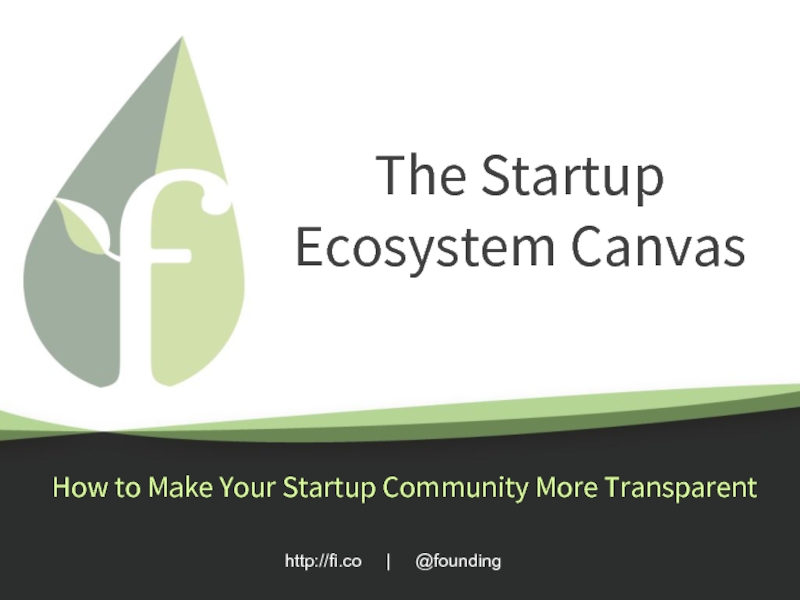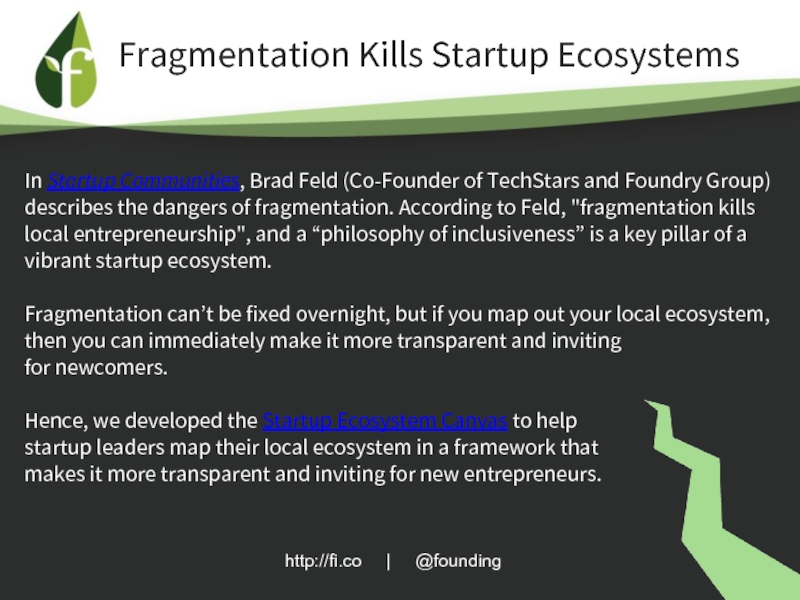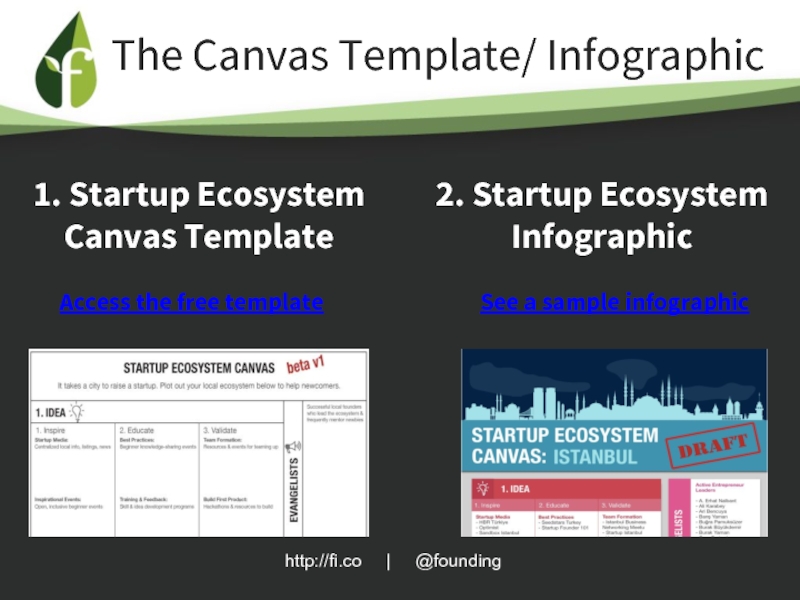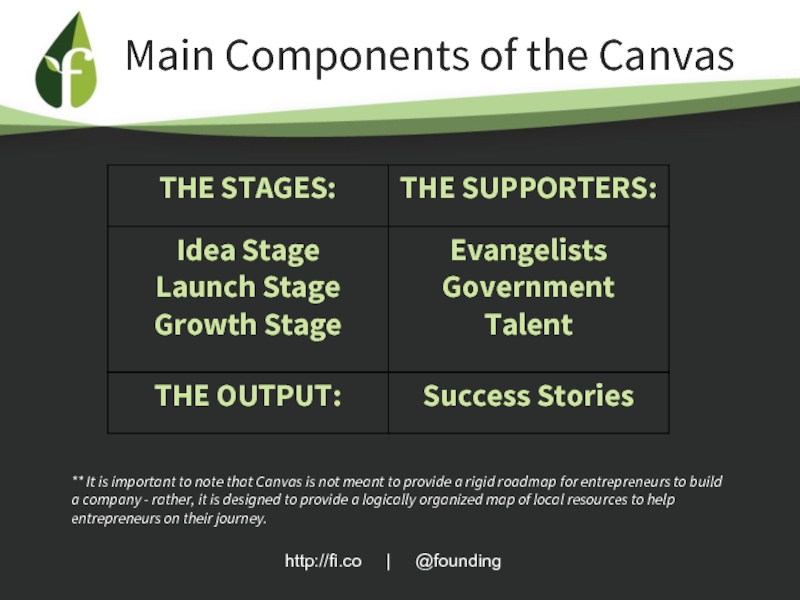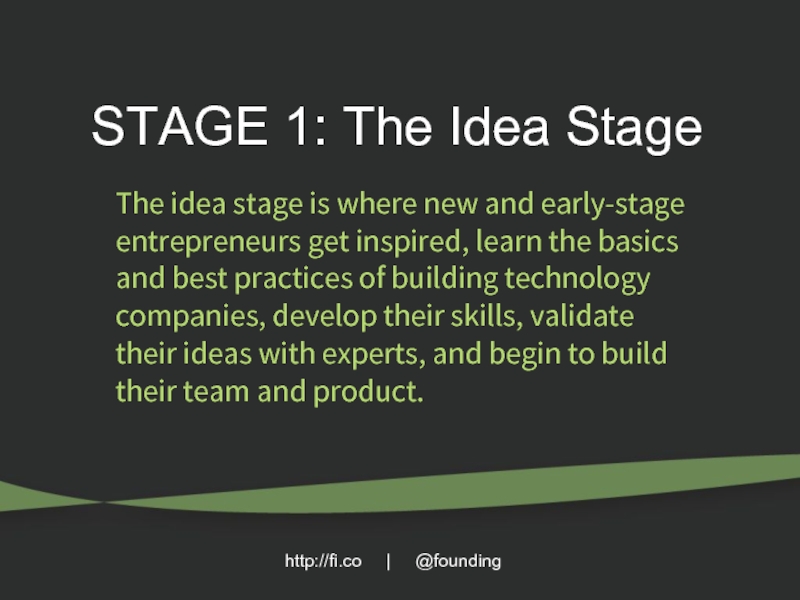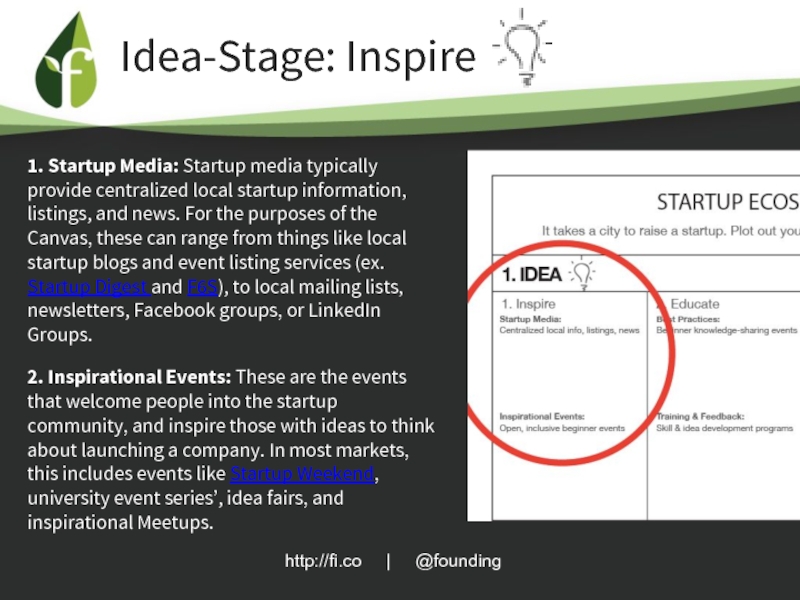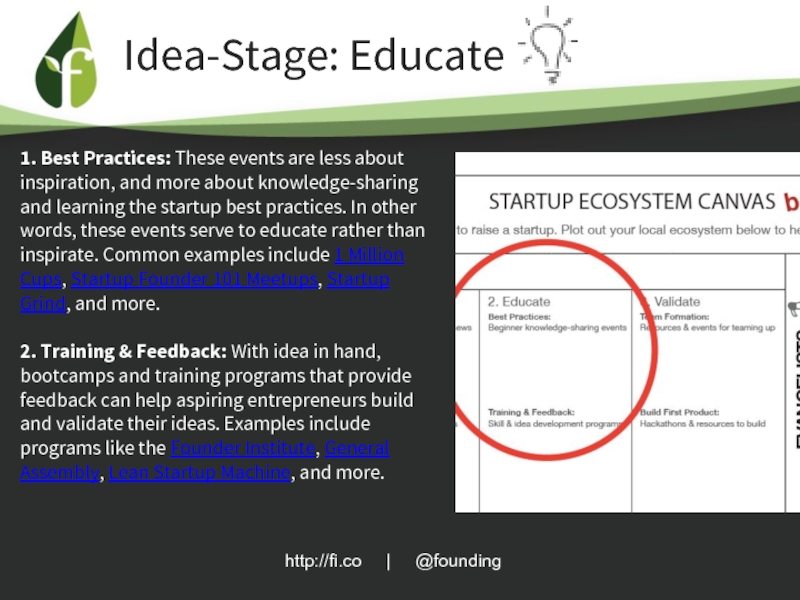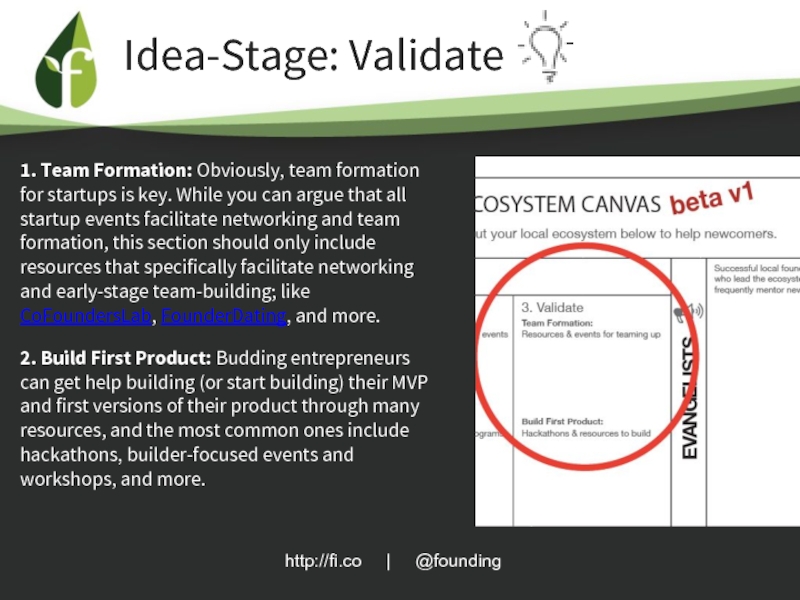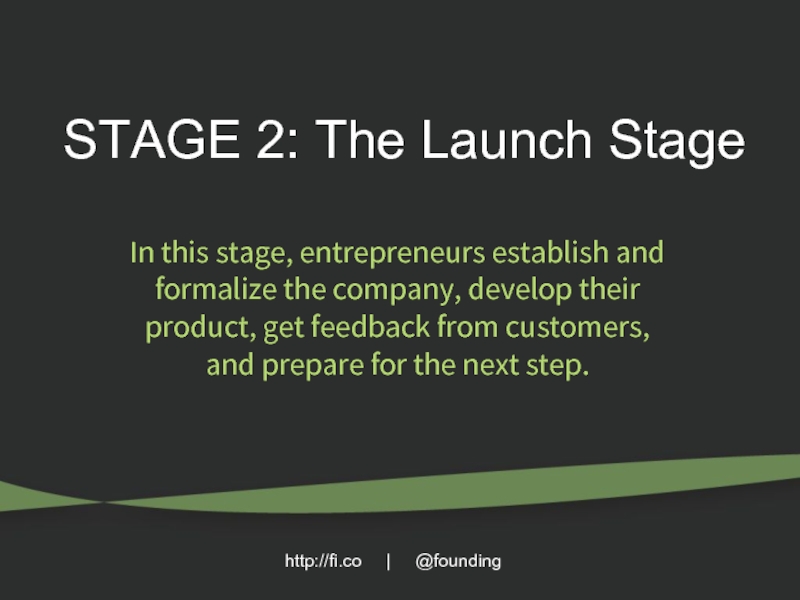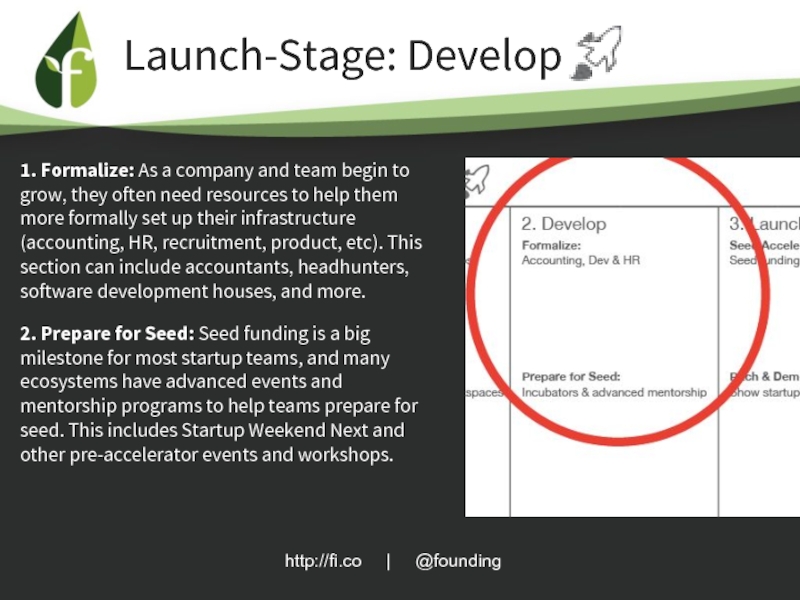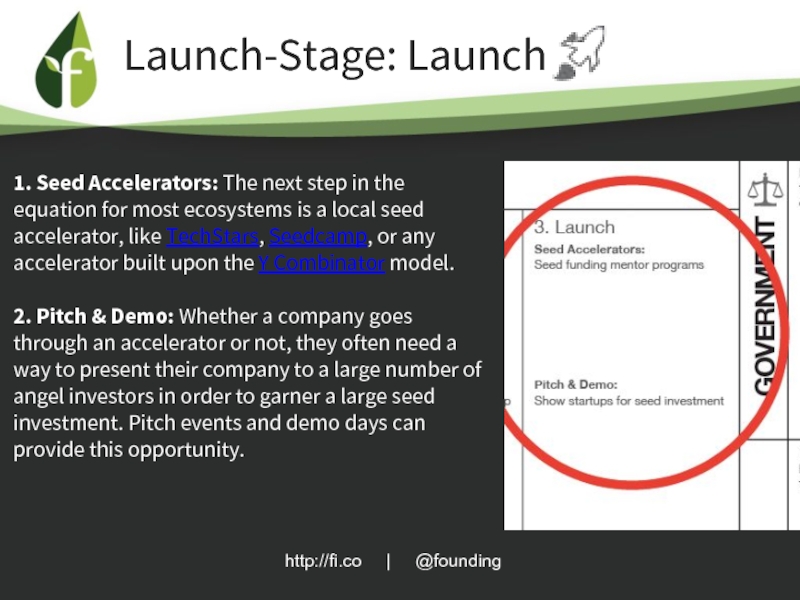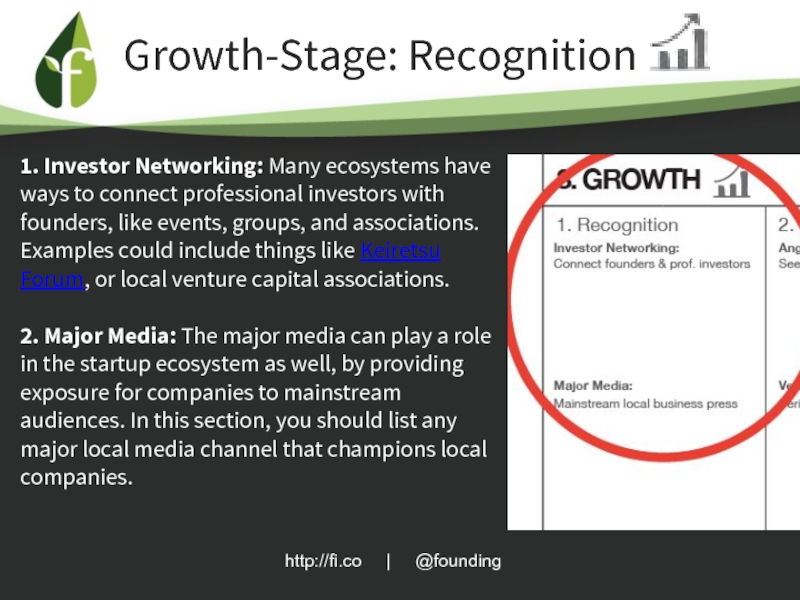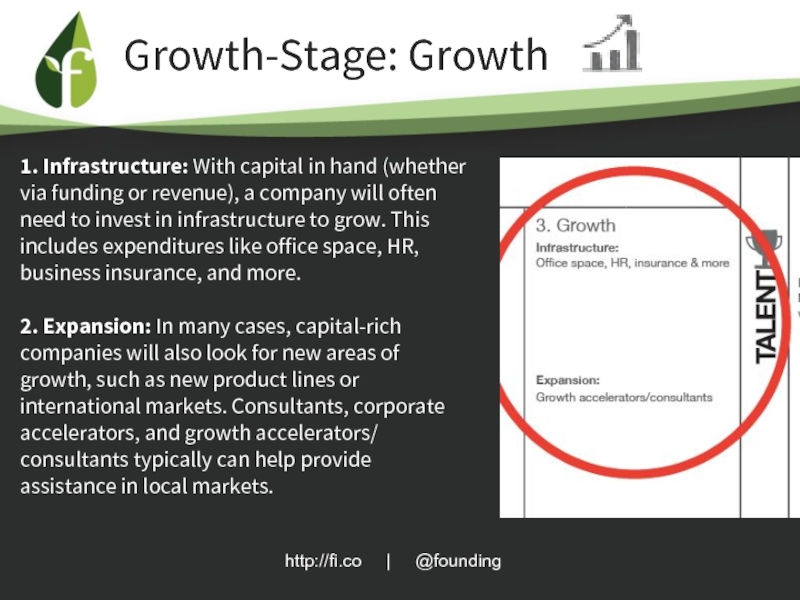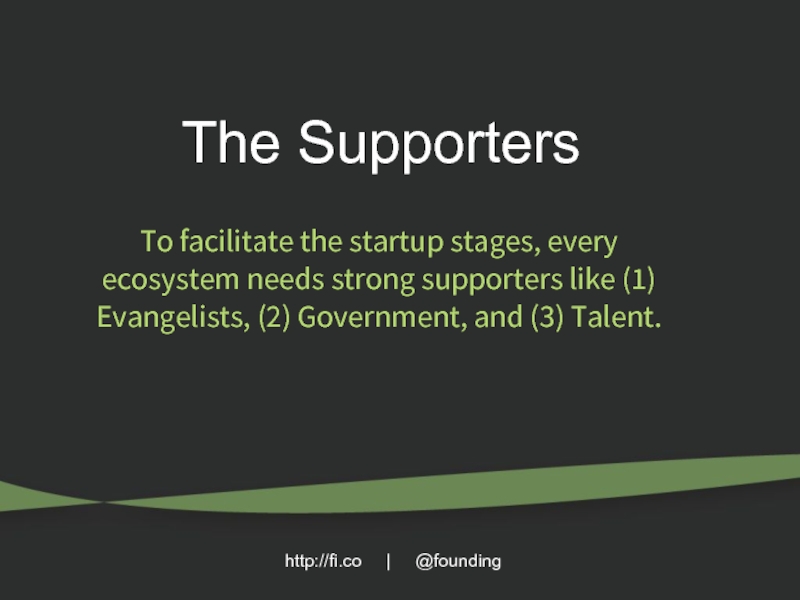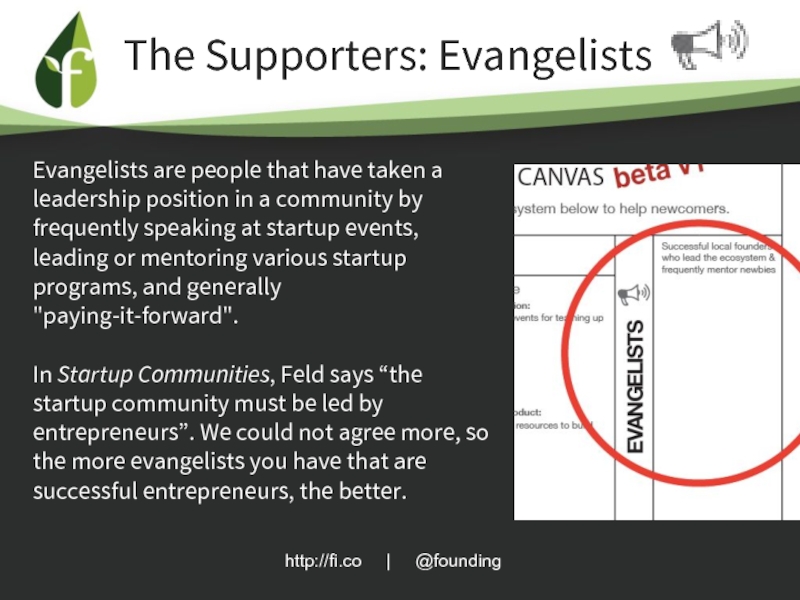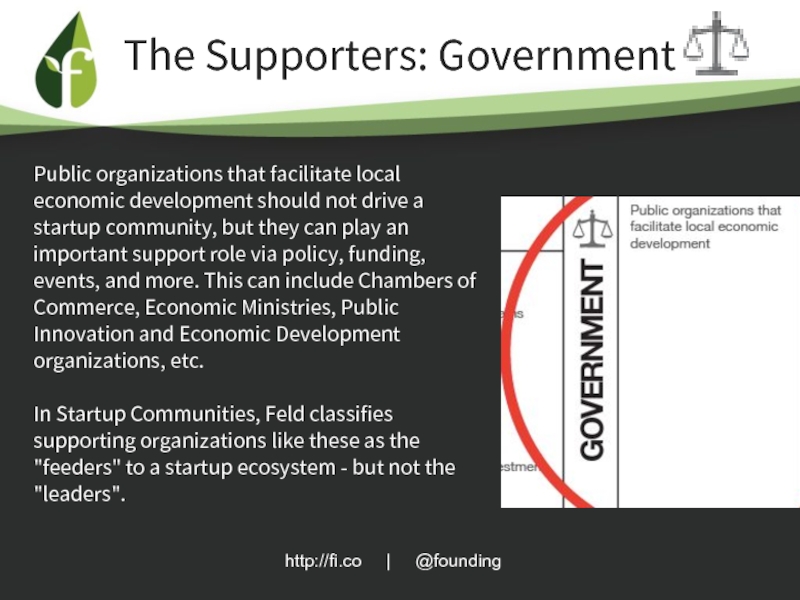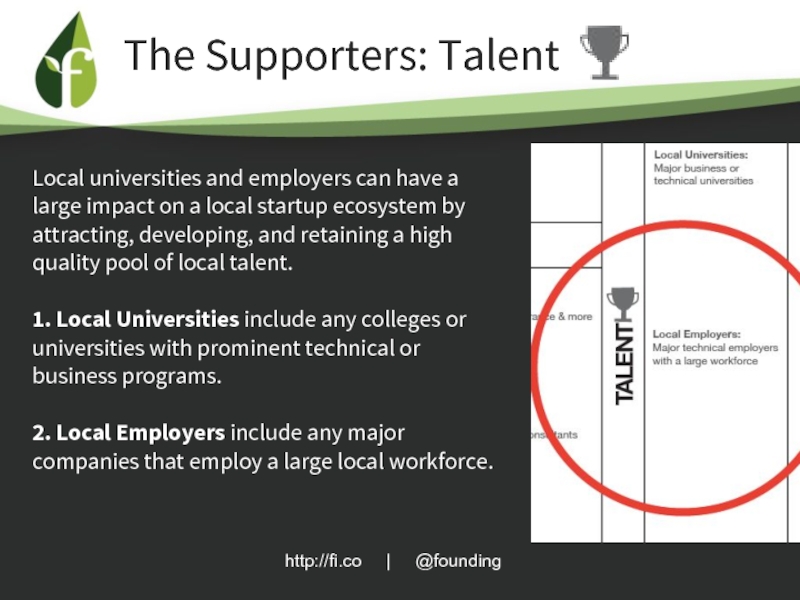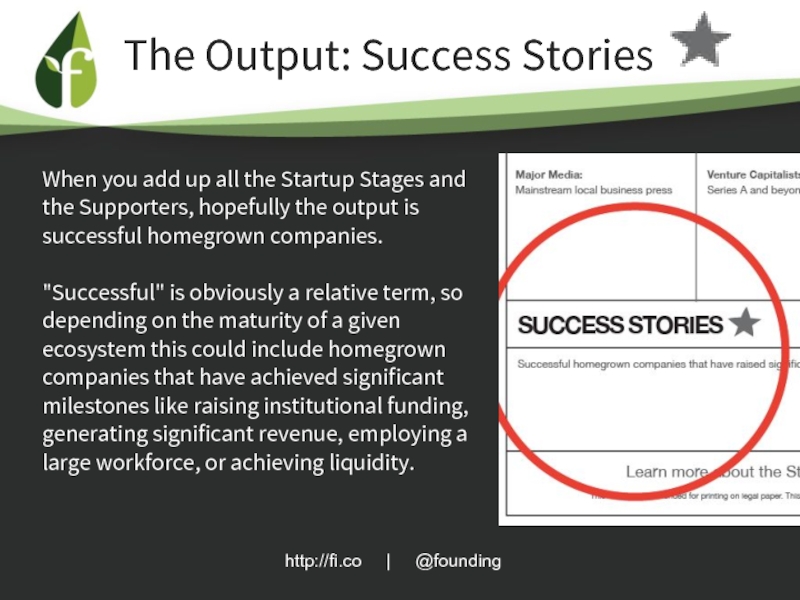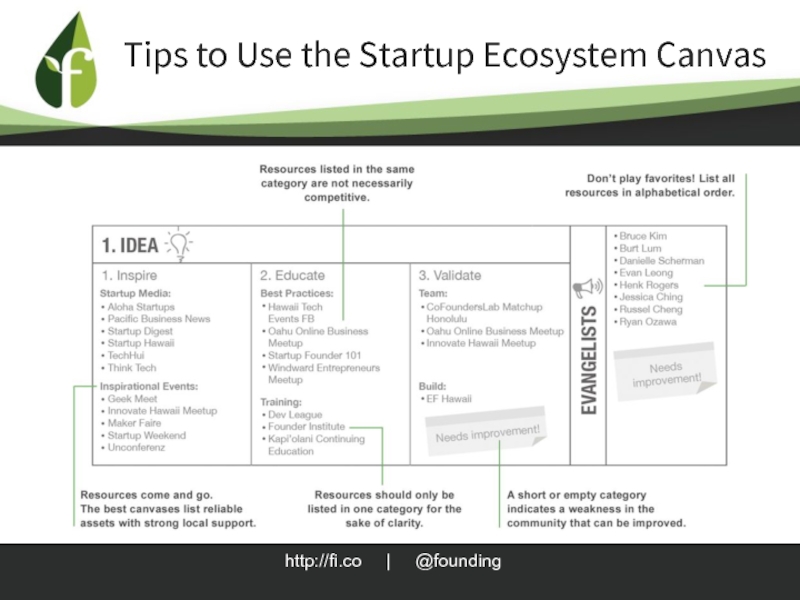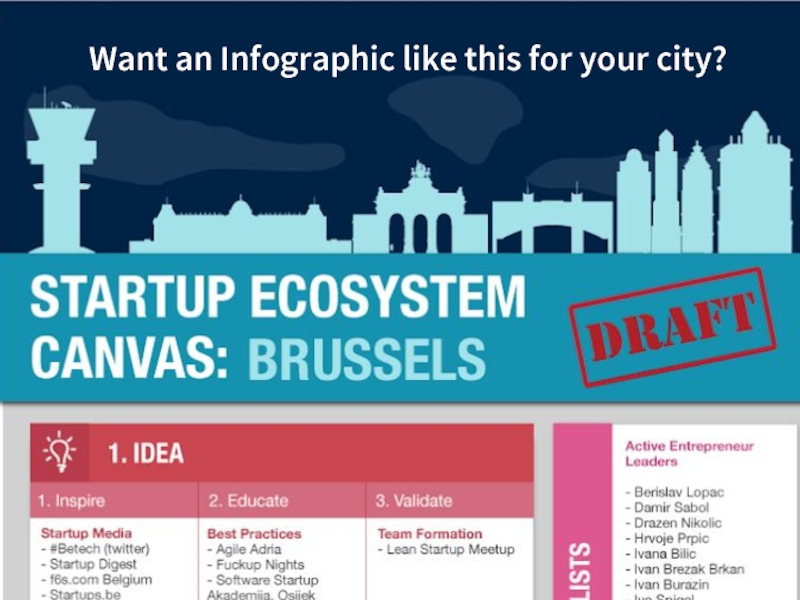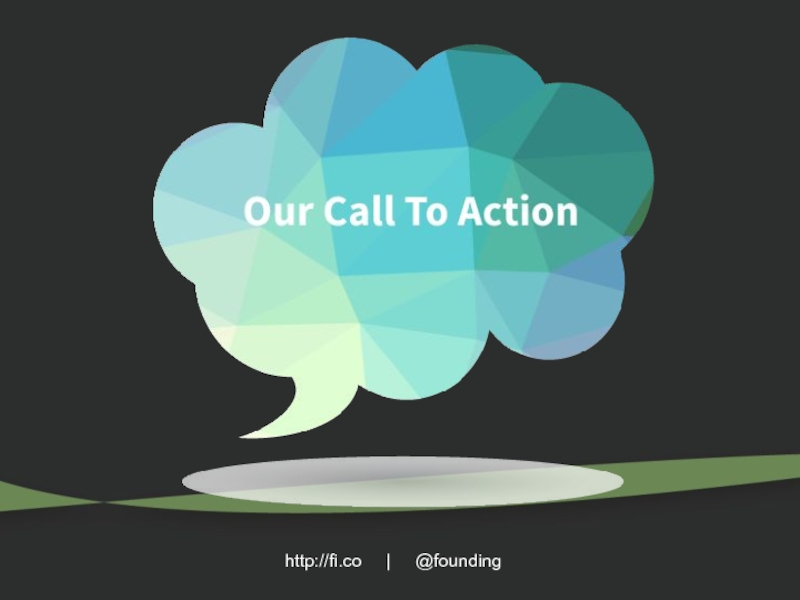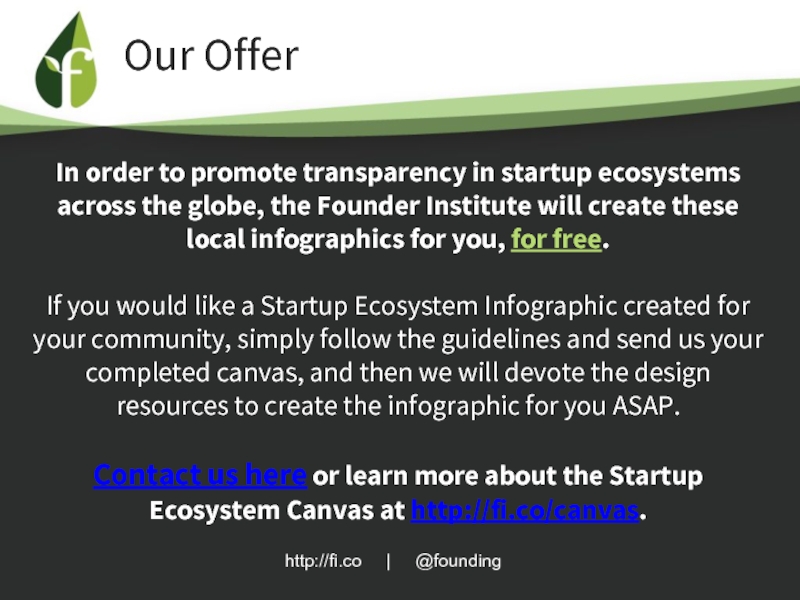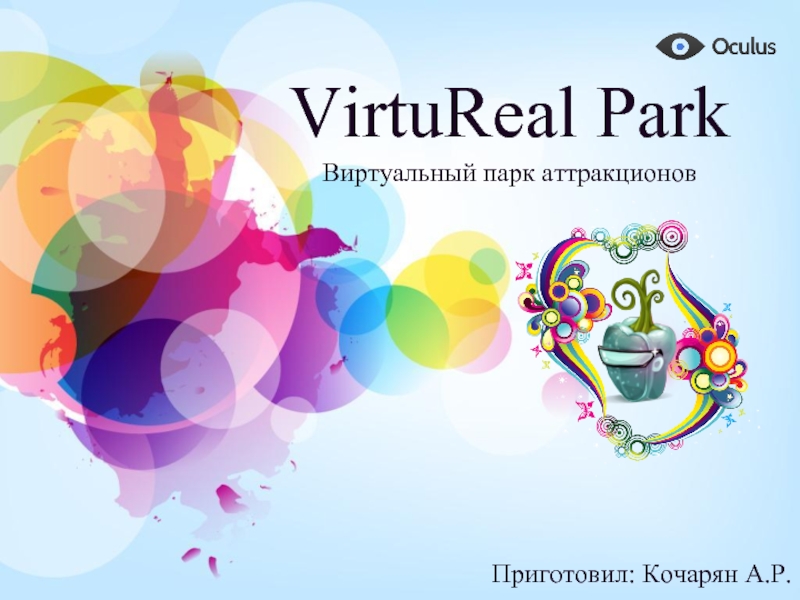- Главная
- Разное
- Дизайн
- Бизнес и предпринимательство
- Аналитика
- Образование
- Развлечения
- Красота и здоровье
- Финансы
- Государство
- Путешествия
- Спорт
- Недвижимость
- Армия
- Графика
- Культурология
- Еда и кулинария
- Лингвистика
- Английский язык
- Астрономия
- Алгебра
- Биология
- География
- Детские презентации
- Информатика
- История
- Литература
- Маркетинг
- Математика
- Медицина
- Менеджмент
- Музыка
- МХК
- Немецкий язык
- ОБЖ
- Обществознание
- Окружающий мир
- Педагогика
- Русский язык
- Технология
- Физика
- Философия
- Химия
- Шаблоны, картинки для презентаций
- Экология
- Экономика
- Юриспруденция
The Startup Ecosystem Canvas презентация
Содержание
- 1. The Startup Ecosystem Canvas
- 2. Fragmentation Kills Startup Ecosystems In Startup Communities,
- 3. The Canvas Template/ Infographic 1. Startup Ecosystem
- 4. Main Components of the Canvas ** It
- 5. STAGE 1: The Idea Stage The
- 6. 1. Startup Media: Startup media typically provide
- 7. 1. Best Practices: These events are less
- 8. 1. Team Formation: Obviously, team formation for
- 9. In this stage, entrepreneurs establish and formalize
- 10. 1. Establish: This includes resources to help
- 11. 1. Formalize: As a company and team
- 12. 1. Seed Accelerators: The next step in
- 13. Here, a startup proves their utility, receives
- 14. 1. Investor Networking: Many ecosystems have ways
- 15. 1. Angels / Micro-VCs: These investors focus
- 16. 1. Infrastructure: With capital in hand (whether
- 17. To facilitate the startup stages, every ecosystem
- 18. Evangelists are people that have taken a
- 19. Public organizations that facilitate local economic development
- 20. Local universities and employers can have a
- 21. When you add up all the Startup
- 22. Tips to Use the Startup Ecosystem Canvas
- 23. Want an Infographic like this for your city?
- 25. In order to promote transparency in startup
Слайд 2Fragmentation Kills Startup Ecosystems
In Startup Communities, Brad Feld (Co-Founder of TechStars
Fragmentation can’t be fixed overnight, but if you map out your local ecosystem, then you can immediately make it more transparent and inviting
for newcomers.
Hence, we developed the Startup Ecosystem Canvas to help
startup leaders map their local ecosystem in a framework that
makes it more transparent and inviting for new entrepreneurs.
Слайд 3The Canvas Template/ Infographic
1. Startup Ecosystem Canvas Template
Access the free
2. Startup Ecosystem Infographic
See a sample infographic
Слайд 4Main Components of the Canvas
** It is important to note that
Слайд 5
STAGE 1: The Idea Stage
The idea stage is where new and
companies, develop their skills, validate
their ideas with experts, and begin to build
their team and product.
Слайд 61. Startup Media: Startup media typically provide centralized local startup information,
2. Inspirational Events: These are the events that welcome people into the startup community, and inspire those with ideas to think about launching a company. In most markets, this includes events like Startup Weekend, university event series’, idea fairs, and inspirational Meetups.
Idea-Stage: Inspire
Слайд 71. Best Practices: These events are less about inspiration, and more
2. Training & Feedback: With idea in hand, bootcamps and training programs that provide feedback can help aspiring entrepreneurs build and validate their ideas. Examples include programs like the Founder Institute, General Assembly, Lean Startup Machine, and more.
Idea-Stage: Educate
Слайд 81. Team Formation: Obviously, team formation for startups is key. While
2. Build First Product: Budding entrepreneurs can get help building (or start building) their MVP and first versions of their product through many resources, and the most common ones include hackathons, builder-focused events and workshops, and more.
Idea-Stage: Validate
Слайд 9In this stage, entrepreneurs establish and formalize the company, develop their
STAGE 2: The Launch Stage
Слайд 101. Establish: This includes resources to help entrepreneurs set up the
2. Workspace: Co-working and flexible workspaces can provide a good breeding ground for new companies. As we are still in the "Launch-Stage", permanent office space is not included at this juncture.
Launch-Stage: Start
Слайд 111. Formalize: As a company and team begin to grow, they
2. Prepare for Seed: Seed funding is a big milestone for most startup teams, and many ecosystems have advanced events and mentorship programs to help teams prepare for seed. This includes Startup Weekend Next and other pre-accelerator events and workshops.
Launch-Stage: Develop
Слайд 121. Seed Accelerators: The next step in the equation for most
2. Pitch & Demo: Whether a company goes through an accelerator or not, they often need a way to present their company to a large number of angel investors in order to garner a large seed investment. Pitch events and demo days can provide this opportunity.
Launch-Stage: Launch
Слайд 13Here, a startup proves their utility, receives recognition, and scales up.
STAGE 3: The Growth Stage
Слайд 141. Investor Networking: Many ecosystems have ways to connect professional investors
2. Major Media: The major media can play a role in the startup ecosystem as well, by providing exposure for companies to mainstream audiences. In this section, you should list any major local media channel that champions local companies.
Growth-Stage: Recognition
Слайд 151. Angels / Micro-VCs: These investors focus on the seed-stage, and
2. Venture Capitalists: These investors typically participate in the Series A stage and beyond, such as institutional venture funds.
Growth-Stage: Funding
Слайд 161. Infrastructure: With capital in hand (whether via funding or revenue),
2. Expansion: In many cases, capital-rich companies will also look for new areas of growth, such as new product lines or international markets. Consultants, corporate accelerators, and growth accelerators/ consultants typically can help provide assistance in local markets.
Growth-Stage: Growth
Слайд 17To facilitate the startup stages, every ecosystem needs strong supporters like
The Supporters
Слайд 18Evangelists are people that have taken a leadership position in a
In Startup Communities, Feld says “the startup community must be led by entrepreneurs”. We could not agree more, so the more evangelists you have that are successful entrepreneurs, the better.
The Supporters: Evangelists
Слайд 19Public organizations that facilitate local economic development should not drive a
In Startup Communities, Feld classifies supporting organizations like these as the "feeders" to a startup ecosystem - but not the "leaders".
The Supporters: Government
Слайд 20Local universities and employers can have a large impact on a
1. Local Universities include any colleges or universities with prominent technical or business programs.
2. Local Employers include any major companies that employ a large local workforce.
The Supporters: Talent
Слайд 21When you add up all the Startup Stages and the Supporters,
"Successful" is obviously a relative term, so depending on the maturity of a given ecosystem this could include homegrown companies that have achieved significant milestones like raising institutional funding, generating significant revenue, employing a large workforce, or achieving liquidity.
The Output: Success Stories
Слайд 25In order to promote transparency in startup ecosystems across the globe,
If you would like a Startup Ecosystem Infographic created for your community, simply follow the guidelines and send us your completed canvas, and then we will devote the design resources to create the infographic for you ASAP.
Contact us here or learn more about the Startup Ecosystem Canvas at http://fi.co/canvas.
Our Offer
